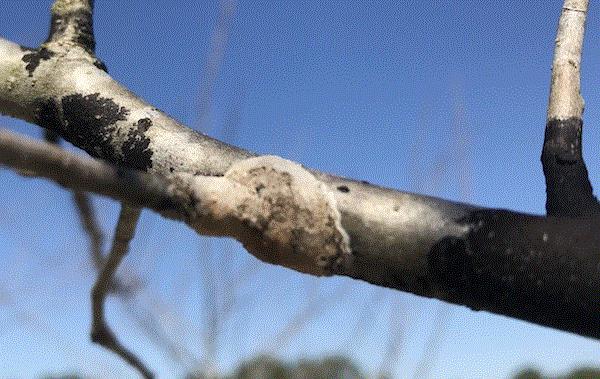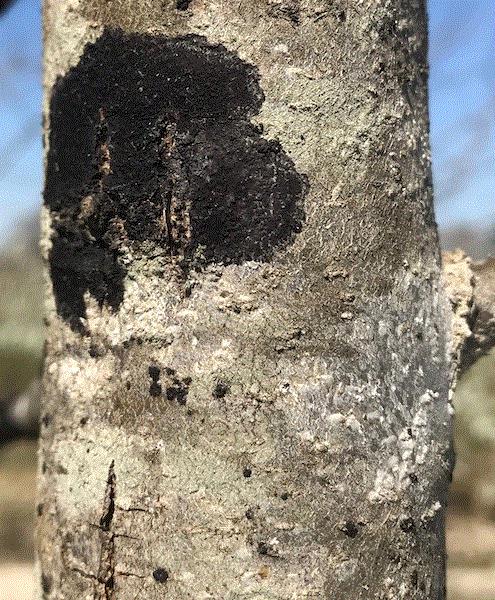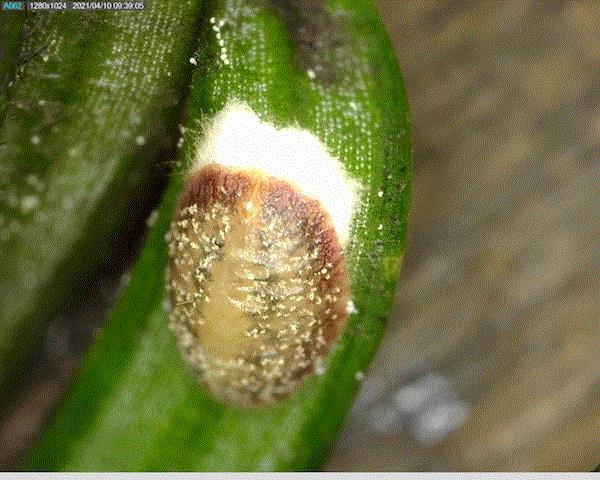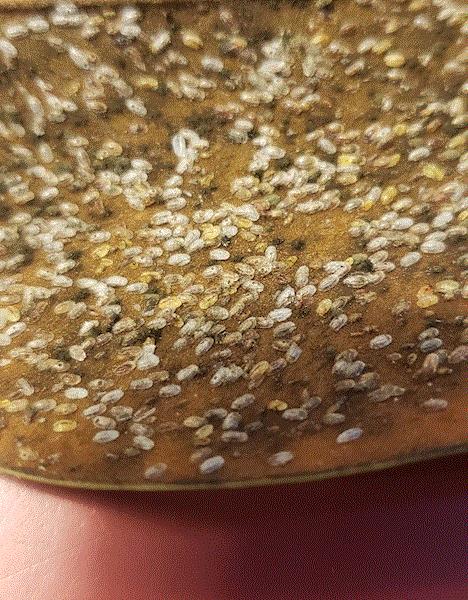Last week’s “What the … ?”
I shared a great “What the …?” mystery last week and asked y’all to identify what looked to be patches of black felt growing on the branches and main trunk of a Wildfire Nyssa. And there are also brown, thick, algae- or lichen-like mats among the mold. Plant tissues underneath the black and brown mats appear alive and healthy. But wait! There's another clue! These trees are infested by scale insects.
John Chapin, Richard Criley, Joanne East, David Englert, Ira Grasgreen, Jacquie Johnson, Carolyn Kinnon and Suzanne Perrin responded and all said, “Sooty mold.” Well … if y’all can see me blowing my fingernails slyly, you know that you’d fallen into a trap I’d placed for you.

All signs point to sooty mold. But, no, it’s not sooty mold. It’s something far more interesting!
Both the black and brown mats belong to the same fungus species in the genus Septobasidium, sometimes called the felt fungus. Y’all probably wonder, “Well, okay, it has a fancy name, but what’s so interesting about it?” Septobasidium is not a plant pathogenic fungus, and therefore, the nyssa tissues under the black and brown mats looked healthy. Septobasidium has a mutualistic relationship with scale insects.
Fungal mycelia interweave and form the black felt. The black mat turns brown as it ages. Within the mat is a series of tunnels and chambers where scale insects reside. The scale insects are alive and feeding on the host plant. At the same time, the fungal hyphae grow from the scale insect bodies and draw nutrients from the scale insects. Sporulation occurs in the spring at the same time when the scale insects are producing hatchlings or crawlers. The crawlers leave the chambers of their mothers and disperse to other parts of the plant or other plants, carrying fungal spores with them. As the scale insect crawlers settle down, the fungal spores also germinate and grow. Over time, a felt is created and covers the scale insects.
So what do the scale insects get out of this relationship? The fungus parasitizes the scale insects by drawing nutrients from the insects. That sounds bad, but by forming the mats, the fungus also provides protection to scale insects from the environment and natural enemies.
The scale insects don’t need the fungus to survive; they can still build a population away from the fungal mat. However, they do better with the fungus protecting them. While the parasitic relationship may reduce scale insect fitness to some degree, it’s still a net positive to the scale insect population. Isn't this relationship cool?

An armored scale colony (in the grey area) can live outside of the black felt fungal mat, but they do better being protected by the fungus.
There are more than one hundred Septobasidium species infesting multiple scale insects and plant species. The definitive work on the relationship between Septobasidium and scale insects is a monograph published in 1938 by John Couch of the University of North Carolina. The scientific illustrations in this book make this a collector’s item ... well, if you dig bug books. You may not be able to find this 480-page book at your local library, but you can find one of Dr. Couch’s earlier papers on the subject by clicking here.
I suppose one clue I could have given that may have helped divert some of you from guessing sooty mold is to mention that the scale insect species found associated with Septobasidium mats is an armored scale, likely a Diaspidiotus (formerly Aspidiotus) species. (I’ll need to get some samples and get them identified.)
Armored scales feed on individual cells, so they don't produce honeydew and sooty mold. Soft scales and other piercing-sucking insects that feed on phloem sap produce a lot of honeydew and sooty mold. Production of honeydew is one way to distinguish soft scales (and mealybugs, aphids, whiteflies, etc.) from armored scales.

Time to think about scales
The Septobasidium piece is a good lead-in to my main topic this week: soft scales.
I've gotten several inquiries in the last two weeks about soft scales because this is about the time for folks in the South to notice the soft scales on their favorite plants. These soft scales are getting fat and full of eggs, which make them more noticeable. I’ve been picking European fruit lecanium off my Fuyū persimmon tree while waiting for my wife’s dog to finish her business. (The dog spends more time sniffing than getting serious about her real business, so I have plenty of time.)
Paul Thompson, horticulture agent of Clemson University Extension Service at York County, South Carolina, found (what I think are) cottony camellia scale on cephalotaxus, which is a relatively pest-free plant species. Gerald Stephens of Nursery Caroliniana in North Augusta, South Carolina, showed me a picture of a southern magnolia leaf covered with tuliptree scale nymphs. These two are new scale insect and host associations to me.

What may be a cottony camellia scale on cephalotaxus. (Photo credit: Paul Thompson, Clenson University Cooperative Extension.)
Before you start, y’all need to figure out what species you have. That’s because management approaches differ depending on where the species feeds and when it produces crawlers or hatchlings—both are related to the species identification.
Systemic insecticides usually work well against a scale insect species that spends its entire life cycle on leaves or one with the immature stage feeding on leaves. You can apply the systemic insecticides to the root zone by granule, drench or injection, or to the trunk by basal trunk spray or injection. The active ingredient will be absorbed by the tree, taken throughout the canopy and concentrated in the leaves where the scale insects are feeding. They drink the juice, ingest the poison and die.

Tuliptree scale nymphs on southern magnolia. (Photo credit: Gerald Stephens, Nursery Caroliniana.)
One systemic insecticide application when the females are getting fat or soon after that is sufficient to reduce the scale insect population. Y’all may have to make multiple yearly applications to clean up the population completely, especially on a large tree.
In my trials, dinotefuran (Safari) is consistently the most effective, followed by other neonicotinoids (clothianidin, imidacloprid and thiamethoxam). Spirotetramat (Kontos) and diamides (chloratraniliprole and cyantraniliprole) are less effective than neonicotinoids. I don't have a lot of data on the efficacy of flupyradifurone (Altus) and sulfoxaflor (+ spinetoram; XXpire) against soft scales on large trees to make a conclusion.
For a species that settles on the branches and trunks its entire life, application of systemic insecticides to the soil and basal trunk didn't perform well in my studies. The most effective products for species that feeds on woody tissues are sprays of insect growth regulators (buprofezin or Talus, and pyriproxyfen or Distance), oil or soap. These products should be applied (usually two or three times every other week) to target hatchlings because the hatchlings have no wax layer on their bodies to protect them from insecticide spray.
Studies by Cliff Sadof of Purdue University and Carlos Quesada, now of West Virginia University, showed that oil is more effective against settled armored scales, whereas soap is more effective against settled soft scales. Insect growth regulators, soap and oil also have the added benefit of being “soft” on the natural enemies, which could be responsible for killing more than 80% of the scale insects before you have to spray.

OHP will be integrated into AMVAC
OHP, Inc. is a familiar name in the greenhouse and nursery industry in the United States. Have you ever used Marathon? What about Azatin, Biathlon, B-Nine, Floramite, Pedestal, Sarisa, Segway and Terrazole? These are all OHP products.
OHP was founded in 1988. In 2017, AMVAC acquired OHP, but continued to operate OHP as an independent subsidiary. The acquisition allows AMVAC to expand its footprint in the non-crop markets through the existing OHP portfolio.
AMVAC and its parent company, American Vanguard, announced on April 7 that OHP would now be integrated into AMVAC’s Environmental Products (AEP) division.
Eric Wintemute, Chairman and CEO of American Vanguard, stated, “The integration … is part of the company’s long-term strategy to increase capacity, broaden product portfolios, and support AEP’s and OHP’s collaborative efforts to develop new biological, biorational and proven chemistry solutions to the market.”
Troy Bettner, Vice President of Marketing and Sales for OHP, will take over from Dan Stahl, OHP Vice President and General Manager, after Mr. Stahl’s retirement in June. Under Mr. Bettner’s leadership, OHP will continue to deliver products and services. OHP products you've trusted will continue to be available.

No more (useless) grass in Las Vegas?
Our world is changing bit-by-bit. Las Vegas will strive to ditch its excesses and indulgence to become a model for restraint and conservation, the Associated Press reported.
After two decades of convincing people to replace lawns with desert plants (and paid $3 per square foot while you were at it), the rate of lawn conversion is slowing down. But the rate of water consumption continues to increase. With reduced rainfall and the future flow of the Colorado River—which supplies 90% of southern Nevada’s water—in question, the math of future water use and supply just doesn’t add up.
The Southern Nevada Water Authority finally had it and asked the Nevada Legislature to outlaw “non-functional” turf in the metro area. Non-functional turf is grass that nobody walks on, which includes stripes of grass grown in street medians, housing developments and office parks. By ripping out the turf, the city can save 15% in annual water consumption or 14 gallons per person per day.
Justin Jones, a county commissioner who serves on the water authority’s board, said, “To be clear, we are not coming after your average homeowner’s backyard.”
The proposal has met resistance, but also garnered support. Its prospect of being approved by the Nevada state legislature is unclear at this time.
Will the same proposal spread to other Southwestern desert cities? Even those who proposed the measure aren’t sure.

Katy, did you do it?
I talked about katydids in the last issue. Hugh Davis of Hugh Davis Horticultural Associates asked a great question, “Why are they called Katydid’s? Is it as simple as something Katy did?”
Well, Hugh, it’s as simple as “Katy did.”
According to Douglas Harper’s Online Etymology Dictionary, katydid is an imitative of the sound made by male katydids. To quote J. Ferdinand D. Smyth’s “A Tour in the United States of America” (1784): “[T]heir noise is loud and incessant, one perpetually and regularly answering the other in notes exactly similar to the words Katy did, or Katy Katy did, repeated by one, and another immediately bawls out Katy didn't, or Katy Katy didn't. In this loud clamour, they continue without ceasing until the fall of the leaf, when they totally disappear.”
The species Mr. Smyth had described may be the common true katydid, Pterophylla camellifolia. If you want to find out what Katy did or didn't do, click here to listen to the songs of the common true katydid.




See y'all later!

JC Chong
Professor of Entomology at Clemson University
This e-mail received by 23,505 subscribers like you!
If you're interested in advertising on PestTalks contact Kim Brown ASAP!